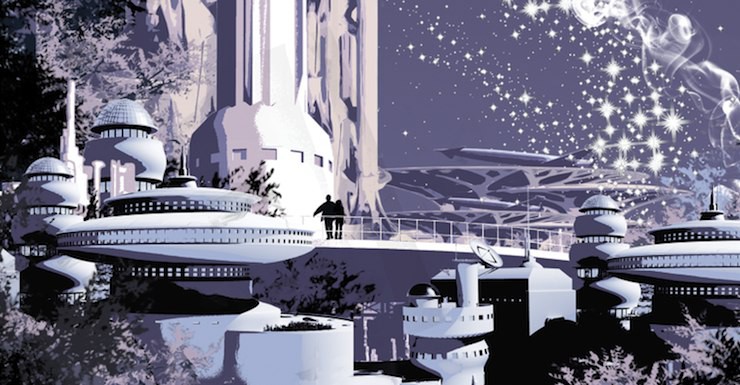Central Station, my new SF novel from Tachyon Publications, is itself a sort of homage to a bygone era of science fiction, one in which many novels were initially published as more or less self-contained stories in magazines before being “collected” into a book. Appropriately, Central Station corresponds with many other works of the corpus of science fiction, though perhaps not always the obvious ones. Here are five novels that helped shape my own work.
Project Pope, Clifford Simak (1981)
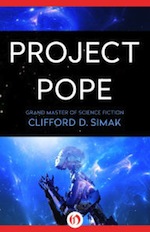 Simak’s been a surprisingly large influence on me. He is far less known today than he was, I think—a rare proponent of “pastoral SF” which resonates with me, I think, partially because of my own upbringing on a remote kibbutz. His best known novel, City, was itself a mosaic or (a somewhat controversial term, it seems) a “fix-up” of short stories, which was one of the obvious inspirations for Central Station.
Simak’s been a surprisingly large influence on me. He is far less known today than he was, I think—a rare proponent of “pastoral SF” which resonates with me, I think, partially because of my own upbringing on a remote kibbutz. His best known novel, City, was itself a mosaic or (a somewhat controversial term, it seems) a “fix-up” of short stories, which was one of the obvious inspirations for Central Station.
Project Pope, however, concerns itself with a society of robots on a remote planet who have established their own Vatican in search of God. It’s a minor Simak, but it’s directly influenced my own order of world-weary robots, who dream of children of their own, follow the Way of Robots, act as sort of neighbourhood priests, and go on pilgrimage (the ‘robot hajj’) to their own Vatican in Tong Yun City on Mars… in Central Station, the local robot, R. Brother Fix-It, doubles up as the moyel for the Jewish community—I don’t think Simak ever wrote a circumcision scene!
It’s an odd book, the sort of science fiction I loved growing up but which seems to increasingly vanish into the past with the demands of more commercial story telling.
Norstrilia, Cordwainer Smith (1975)
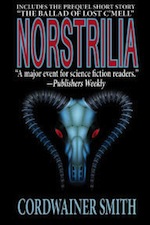 Smith is, of course, a massive influence on my own work. He was such a unique writer that, were I to rewrite the history of American science fiction, I would position Smith as one of the three central figures in the literature, far more important in my own pantheon than Heinlein or Asimov are to others. He was a reclusive figure, the godson of Sun Yat-Sen, an OSS officer, an expert on psychological warfare, and a science fiction writer who created one of the most compelling “future histories” in the field, in a series of short stories that hint at far more than they show. He only wrote one novel, Norstrilia, about a boy who bought the planet Earth, travelled there, and came back alive. This is the story, as Smith tells us in the very first chapter… everything else is the details.
Smith is, of course, a massive influence on my own work. He was such a unique writer that, were I to rewrite the history of American science fiction, I would position Smith as one of the three central figures in the literature, far more important in my own pantheon than Heinlein or Asimov are to others. He was a reclusive figure, the godson of Sun Yat-Sen, an OSS officer, an expert on psychological warfare, and a science fiction writer who created one of the most compelling “future histories” in the field, in a series of short stories that hint at far more than they show. He only wrote one novel, Norstrilia, about a boy who bought the planet Earth, travelled there, and came back alive. This is the story, as Smith tells us in the very first chapter… everything else is the details.
Central Station itself takes place within a wider universe, inspired by Smith’s storytelling method, and which I have been working on for about a decade. Many obscure references, therefore, may lead the unwary reader to a story published elsewhere, but that is not necessary for the reading, of course. What Smith did so brilliantly was evoke the sense of a universe already ancient, filled with a history already turning into myth and legend.
Shambleau, C.L. Moore (1953)
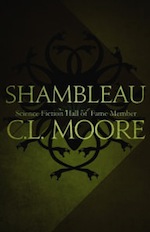 I first read “Shambleau,” Catherine Moore’s most famous story, many years ago, in a Hebrew translation, and it’s never lost its power for me. The story was first published in Weird Tales—even H.P. Lovecraft was impressed by it, soon striking a correspondence with the young Moore and eventually leading to her marriage to Henry Kuttner, another of Lovecraft’s correspondents. Her writing is lush, elegiac, filled with mystery and danger and a sense of excitement, set in a solar system filled with the past. Her hero, Northwest Smith, is a gunslinger of the spaceways, and when he encounters a woman who may just be a vampire of sorts, he can’t help but get involved with her…
I first read “Shambleau,” Catherine Moore’s most famous story, many years ago, in a Hebrew translation, and it’s never lost its power for me. The story was first published in Weird Tales—even H.P. Lovecraft was impressed by it, soon striking a correspondence with the young Moore and eventually leading to her marriage to Henry Kuttner, another of Lovecraft’s correspondents. Her writing is lush, elegiac, filled with mystery and danger and a sense of excitement, set in a solar system filled with the past. Her hero, Northwest Smith, is a gunslinger of the spaceways, and when he encounters a woman who may just be a vampire of sorts, he can’t help but get involved with her…
Moore’s other creation, Jirel of Joiree, led to my own Gorel of Goliris stories of “guns and sorcery,” which include Gorel & The Pot-Bellied God and Black Gods Kiss (the title paying homage to Moore’s “Black God’s Kiss,” of course). And I recently paid homage to her again in “The Drowned Celestial,” a story inspired by her solar system, in the anthology Old Venus edited by Gardner Dozois and George R.R. Martin.
But it is Shambleau, though of a somewhat different nature, who makes her appearance in Central Station, in a scene echoing Moore’s—though I think my Shambleau finds at least a modicum of happiness, in the end…
Ubik, Philip K. Dick (1969)
 Here’s a weird confession to make—as much as I love Philip K. Dick, I hate Ubik. I don’t really know why that should be, but it’s one of my least favourite PKD novels. Everyone I know pretty much universally loves it, while I prefer his far more obscure work, like The Simulacra… but there you have it. It’s impossible to escape from the paranoid claustrophobia of worlds-within-worlds that Dick excelled in, and it provides an additional layer to Central Station’s ever shifting allegiance between the “digitality” and the “physicality,” two worlds that are increasingly the same.
Here’s a weird confession to make—as much as I love Philip K. Dick, I hate Ubik. I don’t really know why that should be, but it’s one of my least favourite PKD novels. Everyone I know pretty much universally loves it, while I prefer his far more obscure work, like The Simulacra… but there you have it. It’s impossible to escape from the paranoid claustrophobia of worlds-within-worlds that Dick excelled in, and it provides an additional layer to Central Station’s ever shifting allegiance between the “digitality” and the “physicality,” two worlds that are increasingly the same.
Pilgrimage: The Book of the People, Zenna Henderson (1961)
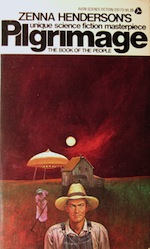 Zenna Henderson’s name may not be an obvious one, but her stories of the People, collected in Pilgrimage and subsequent volumes, are both an example of a mosaic novel and of the sort of pastoral SF only Simak was also doing. Her stories were all about children, and at the heart of Central Station is the mystery of the children born on the station, what they are, what they might one day be. Though I have not re-read Henderson in many years, I cannot deny the influence that her work has had on mine, and for years I’d recommend her work as a sort of getaway drug into science fiction.
Zenna Henderson’s name may not be an obvious one, but her stories of the People, collected in Pilgrimage and subsequent volumes, are both an example of a mosaic novel and of the sort of pastoral SF only Simak was also doing. Her stories were all about children, and at the heart of Central Station is the mystery of the children born on the station, what they are, what they might one day be. Though I have not re-read Henderson in many years, I cannot deny the influence that her work has had on mine, and for years I’d recommend her work as a sort of getaway drug into science fiction.
opens in a new window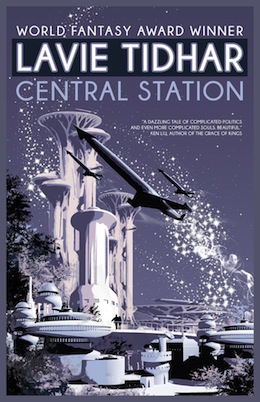 British Science Fiction and World Fantasy Award-winning author Lavie Tidhar was born in Israel. He has lived all over the world, including in Vanuatu, Laos, and South Africa, and is currently making his home in London. Tidhar has been compared to Philip K. Dick by the Guardian and to Kurt Vonnegut by Locus. His most recent novel, Central Station, is available now from Tachyon Publications.
British Science Fiction and World Fantasy Award-winning author Lavie Tidhar was born in Israel. He has lived all over the world, including in Vanuatu, Laos, and South Africa, and is currently making his home in London. Tidhar has been compared to Philip K. Dick by the Guardian and to Kurt Vonnegut by Locus. His most recent novel, Central Station, is available now from Tachyon Publications.










